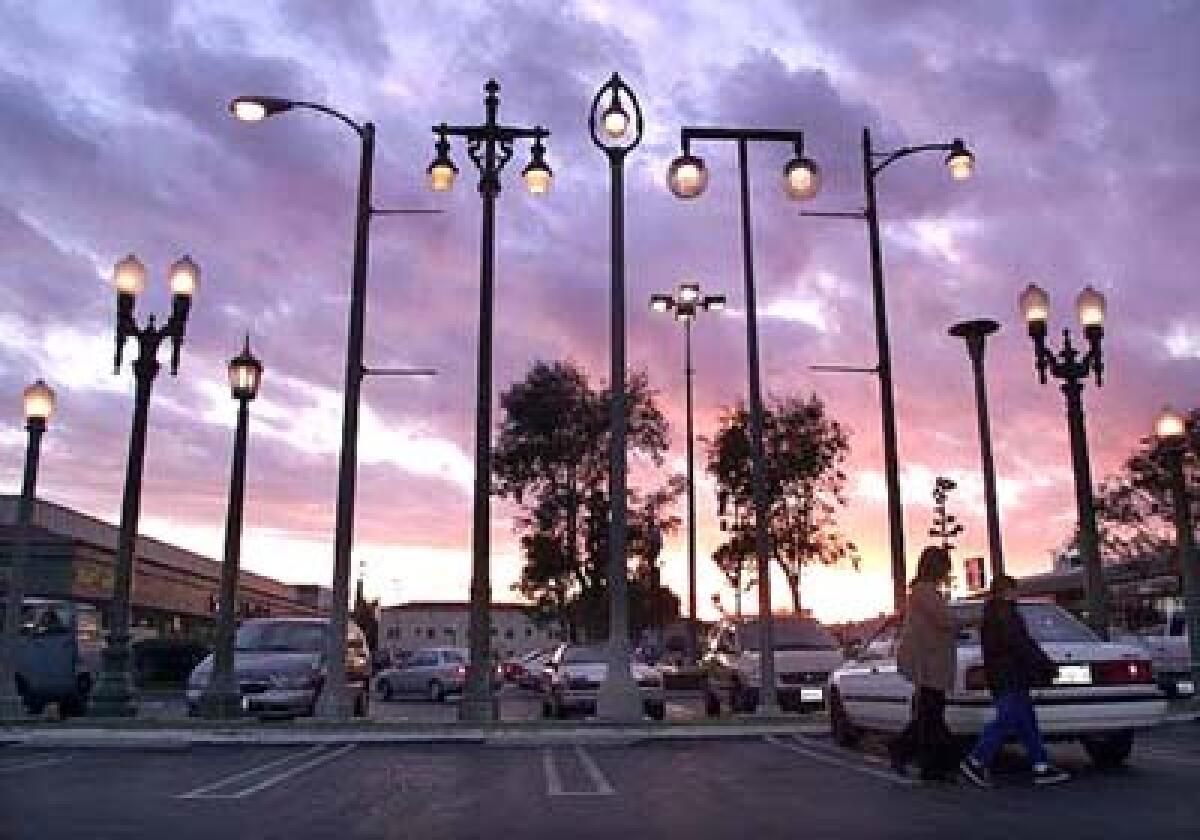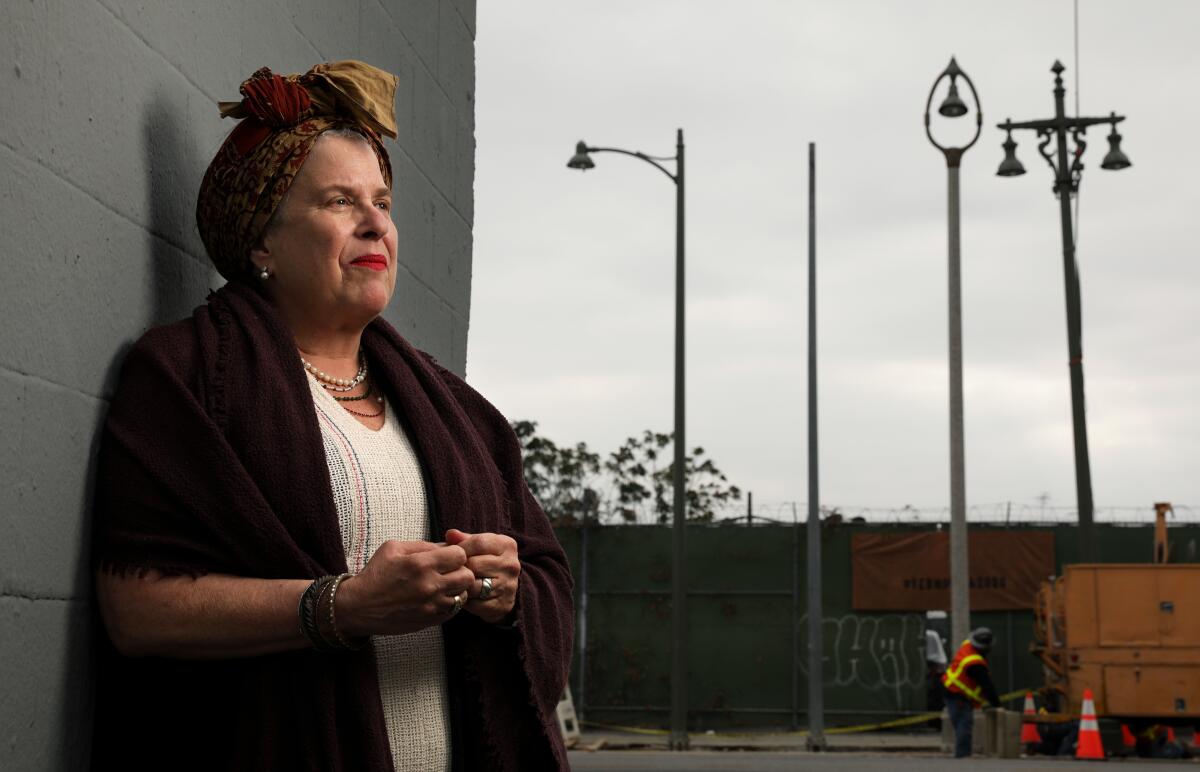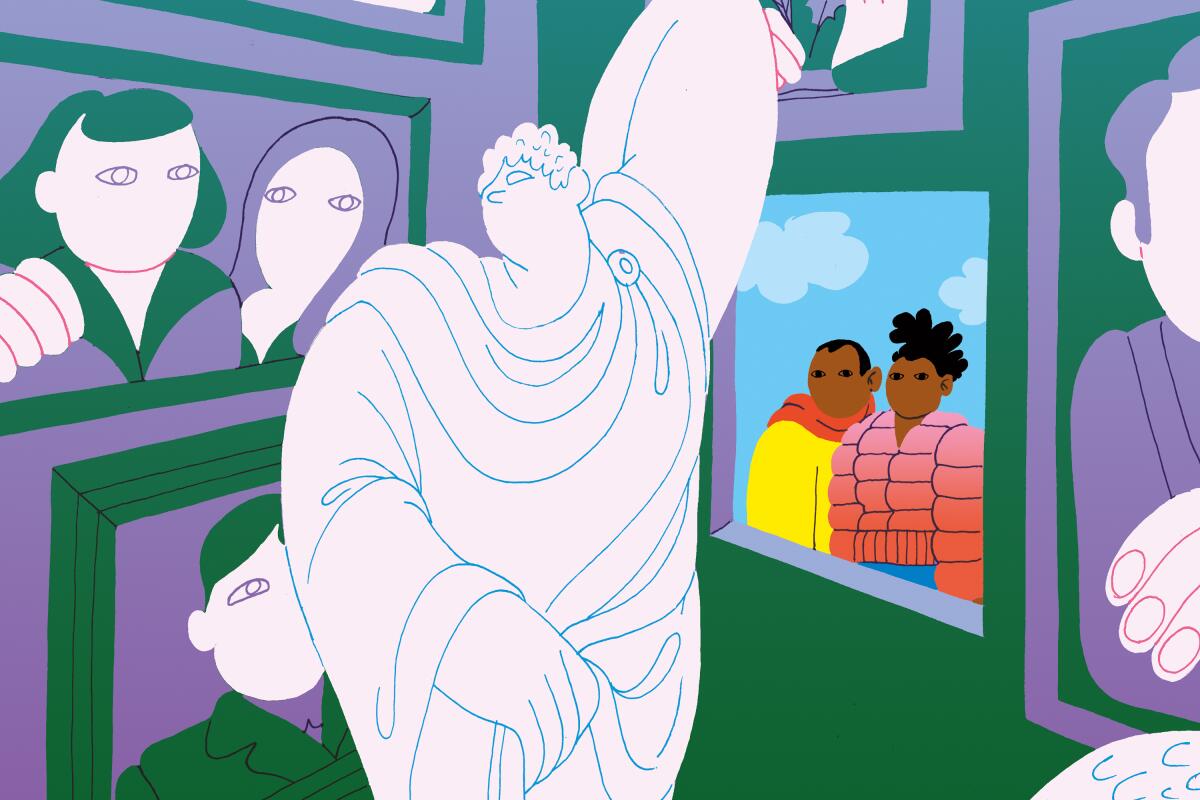Essential Arts: Sheila Klein’s beloved ‘Vermonica’ finds a new home

Welcome to the weekend! I’m Carolina A. Miranda, the newly baptized arts and urban design columnist at the Los Angeles Times — (!!!) — and I’m celebrating with a vat of take-out margaritas from El Coyote. With a little bit of lime and a lot of tequila, the week’s essential culture news:
‘Vermonica’ is reborn
In 1993, artist Sheila Klein created a sculptural installation out of 25 vintage light poles in the median of a run-of-the-mill strip mall at the intersection of Santa Monica Boulevard and Vermont Avenue in East Hollywood. The piece, titled “Vermonica,” was crafted as a gesture of healing: an illuminating monument to mark a site that had gone up in flames during the 1992 Los Angeles riots. (Worth noting: The installation predates Chris Burden’s “Urban Light” at the Los Angeles County Museum of Art by 15 years.)
Fast-forward 24 years to November 2017, when the sculpture was mysteriously removed by the Bureau of Street Lighting without notice. It then materialized in a reconfigured state before the bureau’s headquarters a block to the east. The strip mall owner had asked for the piece to be removed to accommodate some construction. But engineers for the bureau had failed to notify Klein or the Department of Cultural Affairs.
Controversy, naturally, ensued. Part of the problem stemmed from the fact that “Vermonica” occupied a legal gray area: The bureau had supplied the light poles and Klein had made the work with a small grant from the Department of Cultural Affairs, but the sculpture stood on private property and had never been formally acquired by the city of L.A.
Thankfully for Los Angeles — which has a long tradition of producing art in unofficial spaces — that has now been resolved.

This week, Klein and engineers from the Bureau of Street Lighting began installing “Vermonica” at its new location: strung along a public sidewalk across the street from the Cahuenga Branch Library on Santa Monica Boulevard at Lyman Place (about a block from the sculpture’s original location). Moreover, the Department of Cultural Affairs general manager, Danielle Brazell, says that the work has been formally acquired by the city: “We now have her work in our permanent collection for all to enjoy.”
Klein says it’s “really thrilling” to find a permanent home for her beloved piece. “I feel like I’m able to provide a bright spot at this time and in this particular neighborhood,” she says. “I really like the way it makes a new hub or place out of that area.”
Make the most of L.A.
Get our guide to events and happenings in the SoCal arts scene. In your inbox once a week.
You may occasionally receive promotional content from the Los Angeles Times.
The artist, who now lives in Washington state, but came back to L.A. for the installation, estimates that it will take another two weeks to complete the work. In December, she hopes to stage a small illumination ceremony. (Whether that is feasible, given the pandemic, is being determined.)
In the meantime, check out this brief, stop-motion video of the work in progress produced by Esotouric, which first brought the sculpture’s removal to light.
End-of-museum times
It has been the summer of reckoning at museums — their finances, cratered by the pandemic; their equity issues, made public by the uprisings. Institutions around the country face an intersecting array of challenges, including employees who have grown increasingly restive over issues of inequity. “There are two uprisings against museums,” Nizan Shaked, a professor of art history and museum studies at Cal State Long Beach tells me. “One is around economics and the ethics of wealth, and the other is around issues of race and historical discrimination, and they meet at the infrastructural level.”
I go through all of it in a lengthy report, taking a hard look at issues of economic equity — such as museum directors, for example, who pull in six- and seven-figure salaries while entry-level visitor associates barely break minimum wage. I also comb through the diversity stats, which are bad all around, but especially bad once you hit the museum boards, which are frequently most preoccupied with funding shiny new wings over endowments for equitable wages.

As part of my story I touched on a controversial plan by the Baltimore Museum of Art to deaccession canvases by Brice Marden, Andy Warhol and Clifford Styll in order to support wage equity. Times art critic Christopher Knight digs into the story, stating that the mechanics of the sales have involved “cringe-inducing carelessness.” This includes a lack of competitive bidding for the Warhol (priced at $20 million less than a similar one sold at auction three years ago). The whole kerfuffle has led a former board chair to quit and led a past chair to reach out to the Maryland attorney general’s office.
“Rather than trash the art collection, suppose the museum had done some sharp-eyed community-building,” writes Knight. “Suppose it launched a social equity capital campaign to achieve its goals. The $2.5-million annual expenditure reportedly required to fully fund Bedford’s vision of equity and collection care is relatively modest.”
That’s not where the story ends though: On Friday, the Washington Post reported that two former BMA board chairmen, Charles Newhall III and Stiles Colwill, announced that they will rescind planned gifts totaling $50 million because of the deaccession plan. The board’s chairwoman, however, said in an email that the museum has no record of the $50-million pledge.
Plus, Sebastian Smee reports on the ongoing controversy over the postponement of the Philip Guston show by the National Gallery of Art and several other institutions. “As institutions face social problems,” L.A. artist Charles Gaines tells Smee, “they are ill-equipped to handle them because there is no diversity.”
And while we’re on the subject of museum reckonings, I had a look at a project that emerged out of the Museum of Modern Art in New York. “Among Others: Blackness at MoMA” is a thorough examination, in book form, of the ways in which the museum has engaged Black artists. On its own, the book won’t fix MoMA’s structural issues. It is, however, a beginning.
Back to the future
Times culture critic Mary McNamara has a poignant conversation with actor-director Joe Mantello, who recently directed the film version of the LGBTQ classic “The Boys in the Band.” The pair talk theater, but they also talk politics: namely the nomination of Amy Coney Barrett to the U.S. Supreme Court, a figure who has publicly defined marriage as being between a man and a woman, and an appointment that could put the future of gay marriage at risk. Of President Trump, says Mantello, “A president who has had three marriages — I’m always just baffled by the hypocrisy; it’s just beyond me.”
Enjoying this newsletter? Consider subscribing to the Los Angeles Times
Your support helps us deliver the news that matters most. Become a subscriber.
Art and about
If you are jonesing for art, parts of the Hammer Museum’s “Made in L.A.” biennial have quietly opened to the public, with various installations located within coffee shops and on billboards. The Times’ Deborah Vankin hit the road to check out some of the pieces. They include Larry Johnson’s billboard project in the MacArthur Park area, which make references to the neighborhood, and Kahlil Joseph’s video installation “BLKNWS,” a work that challenges the idea of what constitutes news. Of Joseph’s work, which was one the talked-about installations at the 2019 Venice Bienniale, “Made in L.A.” co-curator Lauren Mackler says, “It creates a framework that’s recognizable, that’s familiar like the news, and it upends that by having content that’s a counternarrative.”
Since the 1980s, L.A. artist Kim Abeles has created a series of works titled Smog Collectors that employ smog as a material. For these, she places a stencil on a scrap of wood, for example, then leaves it to the environment to do the painting for her: As particulates settle, they stick to the surface. The Times’ Laura Zornosa reports that Abeles has been making new work with the smoke and ash unleashed by the Bobcat fire. The pieces offer dark commentary on the state of our environment: “This tipping point has arrived,” says Abeles. “It’s not something that’s going to happen 10 years from now.”
Painter Linda Stark takes the common pictogram of a heart and turns it into a visceral object in a solo show at David Kordansky Gallery (closing today). I spoke with her about why she centered an entire series of works around the heart — but also why another body part (ovaries!) regularly appear in her work. “It began as my personal ‘women unite’ symbol,” she says. “The female reproductive system is this emblematic heraldic form.”
Performing arts
Times theater critic Charles McNulty has found an intriguing online theatrical offering in Scott Silven’s “The Journey,” which is being produced by the Broad Stage. It’s a truly collective experience, as viewers become part of this illusionist’s work. “This is not a show in which you can remain invisible in your seat,” writes McNulty. “Silven depends on the participation of audience members. His powers of mental telepathy are put to a unique end: to reveal that, though we can no longer safely gather inside a theater, our interconnectedness continues on a parallel plane.”
Times classical music critic Mark Swed, feeling devilish, is recommending Russian composer Alexander Scriabin’s “Ninth Sonata” as part of his deep listening series. It’s a composition that is more popularly known as “The Black Mass.” “It lasts only eight to 10 minutes, depending on how fast you dare (or can) play it,” he writes, “but whatever the tempo, it feels much longer, long enough for a spooky rite. The sonata ends, in the words of the wonderful Scriabin biographer Faubion Bowers, with a nightmare march of Gothic visions, ghosts and distorted horrors.’”
Happy Halloween!
The solo bubble
Game critic Todd Martens writes that “we’re starting to see creative attempts at bringing back live entertainment.” Haunt ‘O Ween in Woodland Hills aims “to turn our personal cars into ride vehicles as we drive through elaborately designed show sets.” Concerts and theaters are also trying live performances with audience members divided into distanced social bubbles to prevent the spread of COVID-19 and charging per car instead of per person. But what happens when you live alone and it’s just you in the bubble? Martens talks with three psychiatric experts about an issue many can relate to.

Essential happenings
Matt Cooper comes through with all the listings, including a roundup of virtual happenings that includes a a three-concert series titled “Live From the West Side: Women of Broadway,” that kicks off with a Patti LuPone performance Saturday, and features subsequent gigs by Laura Benanti and Vanessa Williams.
Plus, he’s got all the IRL experiences, including a Day of the Dead installation co-presented by the Music Center and Self Help Graphics in Grand Park.
In addition, the She Loves Collective will stage the performance piece “The Rifles Our Ancestors Didn’t Have,” in a site by the L.A. River in Elysian Valley (a.k.a. Frogtown) on Sunday. The work is intended to draw attention to the ongoing conflict between Armenian and Azerbaijani factions in Nagorno-Karabakh, a territory that is occupied by ethnic Armenians but is considered part of Azerbaijan. (The area is known as Artsakh to Armenians.)
The performance channels the female Armenian freedom fighters of the Ottoman era. (Hrag Vartanian at Hyperallergic has a good primer.) Things get rolling on Sunday at 5:30 p.m. You can find more details on the She Loves Collective Instagram account.
Passages
Anthony Chisholm, a Tony Award-winning actor known for his appearances in Center Theatre Group productions, including a number of August Wilson productions, has died at 77.
Hiroh Kikai, a Japanese photographer known for his frank portraiture and pithy captions, embodied by his “Persona” series, has died at 75.
Aurelio Jose Barrera, a longtime L.A. Times photographer who was part of the team that won a Pulitzer Prize in 1984 for a series on L.A.’s Latino communities, is dead at 60.
In other news
— The Academy Museum of Motion Pictures has named film historian Jacqueline Stewart its chief artistic and programming officer, overseeing exhibitions, programming and education.
— The Geffen Playhouse has announced the next slate of productions of its Geffen Stayhouse offerings, including a magic show called “The Future” and an interactive piece titled “Citizen Detective.”
— Rachel Syme on the role of the gray suit in David Byrne’s work, “a kind of brutalist anti-fashion statement.”
— Speaking of which, if you haven’t read Times pop music critic Mikael Wood’s Q&A with Byrne, it’s really interesting.
— L.A. opera director Yuval Sharon comes through with a drive-through Wagner opera in Detroit. Somebody PLEASE stage this in El Lay.
— A story that involves QAnon, a vegan chef and museum vandalism. Like, whoa.
— For Caturday: a giant pre-Columbian cat was found etched into the desert in Nazca, Peru.
— L.A. artist Maggie West is staging a show across a series of large-scale digital media screens around the city.
— Alissa Walker has an explainer on Trump and his whole thing about “tiny little windows.”
— If you happen to have a cool $25 million on hand, Richard Neutra’s famed Kaufman Desert House in Palm Springs is up for sale.
And last but not least ...
Simone Forti’s “Poems From the Lockdown.” I like the bananas simile.
The biggest entertainment stories
Get our big stories about Hollywood, film, television, music, arts, culture and more right in your inbox as soon as they publish.
You may occasionally receive promotional content from the Los Angeles Times.




